Peter Gowland, one of the most influential of the post war Southern California glamour photographers, says he was profoundly affected by popular illustration of the day and though he doesn’t mention Hawley specifically by name, it’s clear he is referring to Hawley and Janzten in his “how to” books he begins producing in 1953 when he talks about a pin up novice must learn an illustrator’s “poster effect” of contrast and focus to be successful.

Hawley, for his own part at the time, was among the many of the artists Esquire magazine rotated in the magazine and calendar after the war, a list that shows how accomplished and high the standard was at the time-- Thornton Utz, Fritz Willis, De Mers, Robert Patterson, Ward Bracket, Walter Popp, Ernest Chiriaka, Eddie Chan, Al Rossi, and Mike Ludlow, just to name a few, all incredibly top notch!—and how those artists were working away from pin up in many other corners of the illustration industry, including a shrinking market in magazines, but a robust opportunity in expanding paperback and men’s adventure covers, movie posters, and record sleeve art.
The photograph-illustration influence cuts both ways, how one side was responding to the challenge and which side would be the ultimate winner. Hawley’s painting of a young woman in a aerodynamic one piece, hands down by her side, perhaps knee deep in still water, unsmiling, face upturned but eyes closed in ecstasy, owes more to Russ Meyer’s glamour photography of his wife Eve and Diane Webber than it does to prevailing illustration trends of the mid and late 50s. In 1957 “Gidget” is published and followed two years by the movie starring Sandra Dee and bikinis and beaches, Southern California and surfing become national trends and photography takes over chronicling the trends. Illustration all but disappears in swimsuit ads by 1960.

Yet there were the children and babies to fall back on, always so evident in Hawley’s work, winged cherubs and darling snub-nosed tykes, bored little brothers and sisters holding suntan oil or a towel while the adults flirt, sprites in blackface causing havoc or outrageously cute pets or small animals run amok. These touches added the Hawley twist, that touch of humor his work had that other glamour illustrators didn’t.
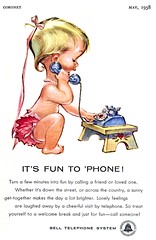 By 1958, it seems this became Hawley’s most recognized and distributed work. He markets his own line of greeting cards and the Hawley enormous eye style becomes a booming business in its own right.
By 1958, it seems this became Hawley’s most recognized and distributed work. He markets his own line of greeting cards and the Hawley enormous eye style becomes a booming business in its own right. But when it became just the unrestrained kids and cute babies, for me, it’s just too much.
I’ll close with this. Is this Pete Hawley?
“Don Lewis” first appeared, as far as I can tell, in 1966 in the pages of Playboy magazine’s quarterly periodical for Playboy Club members, VIP, with six cartoons spread over two years of the club’s trademark waitress Bunny.

Lewis thereafter made just four more appearances in the magazine, late 1966-1968, pin up cartoons. The earlier Bunny cartoons shown here, the keyholder cartoon is dated July 1965, are very tight, done in gouache and watercolor, much tighter than the last three examples in the magazine seemingly done in a loose, offhand watercolor.
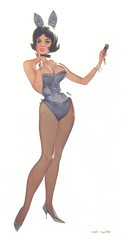
I can find no other mention of Lewis anywhere, in any facet of American illustration or art, from the 30s to the 70s, and no other example except those ten cartoons. (Can any list member help here?) So, if that’s true, it’s likely a pseudonym. Hawley used pseudonyms a lot, wouldn’t it make sense to use one in this instance, especially if his name was associated in the 60s with brand name baby or child-like impossibly cute big eye art? Does it look like Hawley? I think it does. The angular, corseted, small waist, the expert handling of the limbs that is both simple and gorgeous. Note the way the Bunny costume shimmers. Whomever he or she may have been, that artist was no slouch.
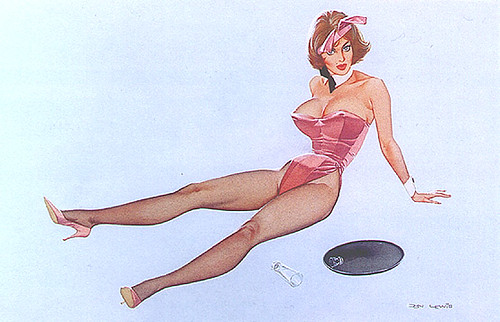
And the eyes, hollowed out without an iris but big and outlined. Gosh, that says Hawley to me.
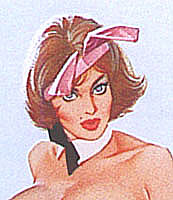
Could it someone else, there were so many good artists then who had the requiste chops. Yes. And I admit, sometimes I waver. One day I’m convinced it’s him. On others, not so sure. (Five of the bunny cartoons were auctioned off by Playboy in 2002, the most coveted going for just under $4000).
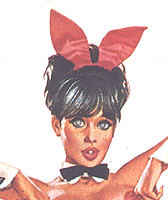
He is such a mystery. Once I saw a Gwen Verdon or Rita Moreno (I think) Broadway musical soundtrack album that had a sparkling mid 50’s, top-of-his-game signed illustration by Hawley. I regret I didn’t buy it right then. Yet a year or so later, for the same title, I saw a different illustration by an un-credited artist straining to look like Hawley as much as possible but not quite managing it.
What’s up with that? I spoke with Shane about it and he had seen it too. Weird.
June 28, 2007
ReplyDeleteFor kicks, I looked for my ex husband's bunny cartoons painted for Playboy Magazine and was led to your site. Just for clarification, Don Lewis is a real person, went to Chicago's American Academy of Art, is an exceptional artist, still 'arting' and resides in northern Indiana. Hugh Hefner always personally approved every cartoon that appeared in the magazine. He was very careful to not override his contract with Vargas when featuring similar cartoons. Hope this helps Leif solve the mystery. M. Lewis
Thanks so much for your comment -- and for shedding some light on the career of Mr. Lewis! If you are still in touch with him, please let him know that there are many people who still very much admire his wonderful artwork. And if he is so inclined, I'd love to ask him in greater detail about his career.
ReplyDeletebest wishes - Leif
HiM. Lewis and Lief, I was looking to have a cartoon drawn of my wife in the old style by one of the old masters. It looks like you may know someone who can help me with this. Can you suggest a contact for me? Thanks.
ReplyDeleteWenlock Free wenlock@mail.com
Leif, Don Lewis just passed away on August 6. I had the pleasure of working with Don for many, many years, hiring him for jobs that I knew only a master could execute...he was such a wonderful artist, not to mention humble. The art world has lost a true talent.
ReplyDelete~Beth Barnes Reiners~